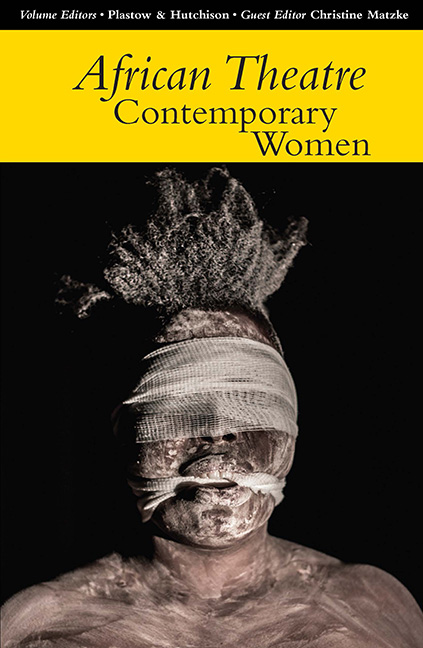Book contents
- Frontmatter
- Contents
- Notes on Contributors
- Editors’ Foreword: Women on the Front Line
- Introduction: Citizen & Artist: African women making theatre
- The Work of Dalia Basiouny: An artist's account
- Performativities as Activism: Addressing gender-based violence & rape culture in South Africa & beyond
- Exploring Poetic Voice in the Uganda Women's Intergenerational Theatre Project
- ‘After Images’: Impressions of the ‘after’ by South African performerchoreographer Mamela Nyamza
- Jalila Baccar of Tunisia: A portrait of an artist
- In Conversation: Interrogating & shifting societal perceptions of women in Botswana through theatre
- Binti Leo: Women in the arts in Tanzania
- Odile Gakire Katese: Making art & reinventing culture with women
- Contemporary Ethiopian Actresses
- Introducing The Sentence
- Playscript
- Book Reviews
The Work of Dalia Basiouny: An artist's account
Published online by Cambridge University Press: 05 July 2016
- Frontmatter
- Contents
- Notes on Contributors
- Editors’ Foreword: Women on the Front Line
- Introduction: Citizen & Artist: African women making theatre
- The Work of Dalia Basiouny: An artist's account
- Performativities as Activism: Addressing gender-based violence & rape culture in South Africa & beyond
- Exploring Poetic Voice in the Uganda Women's Intergenerational Theatre Project
- ‘After Images’: Impressions of the ‘after’ by South African performerchoreographer Mamela Nyamza
- Jalila Baccar of Tunisia: A portrait of an artist
- In Conversation: Interrogating & shifting societal perceptions of women in Botswana through theatre
- Binti Leo: Women in the arts in Tanzania
- Odile Gakire Katese: Making art & reinventing culture with women
- Contemporary Ethiopian Actresses
- Introducing The Sentence
- Playscript
- Book Reviews
Summary
When I was growing up in Egypt I knew of no women stage directors and when I later researched the topic, I found that the first Egyptian woman to direct for the stage was the actress Fatma Roushdy in 1930, who directed seven plays in addition to performing numerous acting roles. The directorial efforts of women in the theatre were sporadic throughout most of the twentieth century, and women directors did not carve out a solid place for themselves until the 1990s (Basiouny, 2013).
I started making theatre in 1988, during my undergraduate studies in the English Department at Cairo University, in the year that the Cairo International Experimental Festival began. This festival came to rescue a stale theatre scene, which was then caught between the calcified state-run theatres living on the glories of 1960s experimentation in form and content, the bawdy commercial theatre mixing cheap laughter with tantalizing dancing, and the unoriginal, uninspired ‘Popular Cultural Authority’ performances.
At that time college theatres were thriving in Cairo University and I tried my hand at many aspects of theatre making. I hung lights, operated primitive sound and light boards, performed small roles, bought and made props, helped to build and paint sets, created pamphlets and hung flyers. After graduation, a number of my colleagues and I formed a small theatre company and I was an assistant director on a number of plays.
I never formally studied directing. I taught myself through watching and reading. I read any book I could lay my hands on about theatre making or directing, while also attending any rehearsals and performances I could find in Cairo. I saw works by various directors. All these directors were men, and most of them screamed violently at their actors and assistants. This was not how I wanted to create theatre. I also watched a lot of ‘bad theatre’ and ‘deadly theatre’. I was teaching myself how to do theatre by learning what notto do!
The Gulf War led to the cancellation of the Experimental Festival in 1991. Many young Egyptian artists soon realized that they did not need an International Festival to perform their work; instead they founded the Free Theatre Festival.
- Type
- Chapter
- Information
- African Theatre 14: Contemporary Women , pp. 6 - 16Publisher: Boydell & BrewerPrint publication year: 2015

